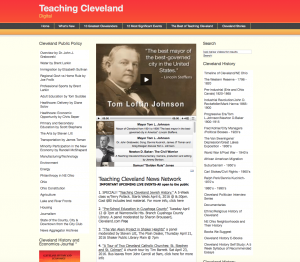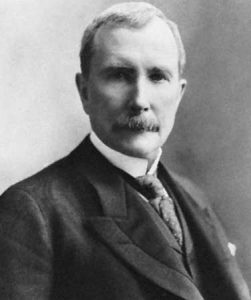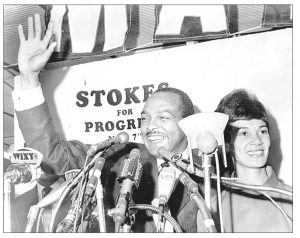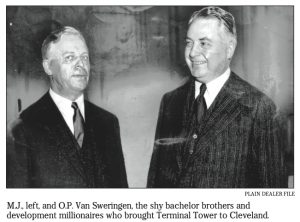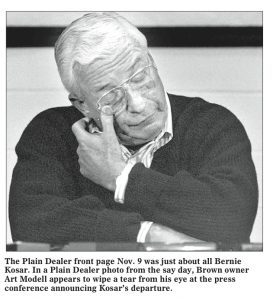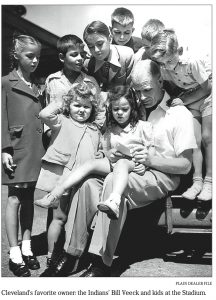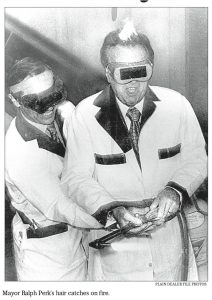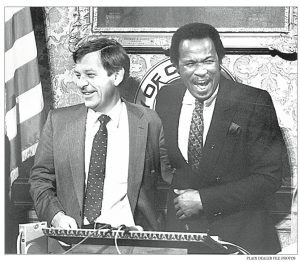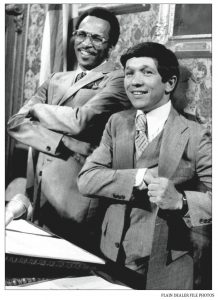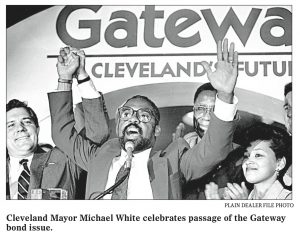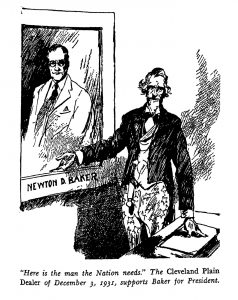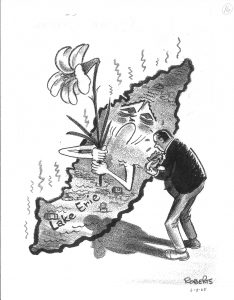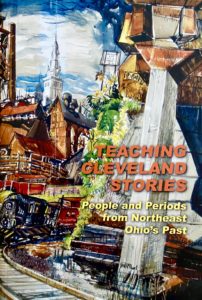This article ran in the Plain Dealer during the Cleveland Bicentennial Year celebration. If you disagree with elements of the list or wish to offer additions, please email us at teachingcleveland@earthlink.net and we can start the discussion.
Courtesy of The Plain Dealer (Cleveland, OH) – Sunday, July 21, 1996
Author: BRENT LARKIN
To borrow from Shakespeare, some are born with greatness. Others achieve it. Some have it thrust upon them.
Greatness is highly subjective. It’s elusive to define and difficult to measure.
And it also can go unnoticed. Imagine how many tens of thousands who have been a part of this area’s rich past, the deeds of their ordinary lives combining to build a great city. They and their memories are as much a part of this Cleveland’s bicentennial celebration as are the leaders who occupy our history books.
But today, on the eve of the city’s 200th birthday, I have set about the difficult task of attempting to determine and rank the 10 greatest Clevelanders – those whose deeds have had the greatest impact on this city and, in some cases, the nation.
The list that appears below is mine alone. But it was compiled after consultations with some of the foremost experts on Cleveland history: John J. Grabowski, director of planning and research at the Western Reserve Historical Society; David D. Van Tassel, professor of history at Case Western Reserve University; Thomas F. Campbell, history professor at Cleveland State University; and George Condon, retired Plain Dealer columnist and the author of several books on Cleveland’s history.
Singling out only 10 Clevelanders (actually, three of the top 10 include, for reasons that will be obvious, two names) for greatness guarantees that many historic figures be excluded, which is a major reason why the list is followed by an honorable-mention section. Ranking them in order is an invitation to second-guessing.
Nevertheless, what follows is one person’s listing of the 10 greatest Clevelanders.
1. Tom L. Johnson (1854-1911): The mayor against whom all others are measured. Elected in 1901, Johnson left a legacy that includes the mall plan, cheap trolley fares, low taxes and, probably above all, the municipal electric system. Johnson was the central figure in planning the city’s development as an industrial power. A successful businessman, he used town hall forums to bring immigrant masses into the political mainstream by instilling in them hope and inspiration. Upon his death, 200,000 people lined Euclid Ave. for the funeral procession.
2. John D. Rockefeller (1839-1937): His family moved from a farm in upstate New York to Strongsville when he was a teenager. After high school, he took a job as an assistant bookkeeper. At 24, he decided to enter the oil business.
So was born the Standard Oil Co., which made Rockefeller one of the world’s richest and most powerful men. This industrialist and philanthropist gave away millions. He built buildings and bought parks here. Criticized by some for moving to New York City in the 1880s, Rockefeller continued to spend summers at his Forest Hills Park estate.
3. Alfred Kelley (1789-1859): Not nearly as well-known as some of the more legendary Clevelanders, in 1915, Kelley became the first president of the village of Cleveland. Back then, Cleveland wasn’t much bigger than any of the other surrounding lakefront cities, like Lorain, Vermilion, Painesville, and others. But Kelley was a man with a dream – a canal that would link Cleveland with the Ohio River and make his city a major industrial port. As a member of the legislature in the 1820s, Kelley dedicated his life to making the Ohio & Erie Canal a reality. When the canal opened in 1827, it secured Cleveland’s place as Ohio’s dominant lakefront city.
4. O.P (1879-1936) and M.J (1881-1935) Van Sweringen: They developed Shaker Heights and Shaker Square, and when they envisioned a rapid-transit system linking the suburb to downtown, a railroad line stood in their way. So, the brothers bought the Nickel Plate Railroad and eventually accumulated a railroad empire consisting of 30,000 miles of tracks valued at $3 billion. Their monument to Cleveland remains today as the city’s most symbolic building – the Terminal Tower. The 1929 stock market crash almost bankrupted them and they died several years later.
5. Marcus Hanna (1837-1904): He was the nation’s first political boss, a cunning and brilliant political strategist universally credited with engineering the election of William McKinley as president in 1896. Elected to the U.S. Senate in 1898, Hanna became a major advocate of an idea many scoffed at – building a canal across Panama. In Cleveland, Hanna was both a wildly successful businessman and the town’s most dominant political figure. His biggest setback in politics was the election as mayor of his longtime enemy, Tom L. Johnson.
6. Newton D. Baker (1871-1937): A protege of Tom L. Johnson, Baker made his mark as mayor of Cleveland from 1912 to 1916. He was responsible for enactment of the City Charter and for promoting passage of the Home Rule amendment to the Ohio Constitution. He made his mark upon the world a few years later. With the nation’s future threatened from abroad, President Woodrow Wilson needed someone to build and train a force of 2 million men to fight the first world war. The choice of Baker as Secretary of War proved outstanding, as Baker was widely credited with succeeding in the most difficult of tasks. Shortly after the war, Baker returned to the Cleveland law firm that still bears his name.
7. Flora Stone Mather (1852-1909) and Samuel Mather (1851-1931): The Mathers were both born into wealth, and through the formation of the iron-ore company Pikands, Mather & Co., saw their separately inherited fortunes grow to the point where they became Ohio’s richest couple. What set them apart from so many other affluent husband-and-wife teams was the vast sums they donated to worthy charities. Major beneficiaries of the Mather fortune were Old Stone Church, Western Reserve University, University Hospitals, John Carroll University and the Community Chest.
8. George Crile (1864-1943): In 1906, while practicing at St. Alexis Hospital, this surgeon and medical researcher performed the world’s first successful blood transfusion. In the Spanish-American War and World War I, he was a highly decorated war surgeon. But Crile’s major contribution to Cleveland came in 1921 when he joined with three others to form the Cleveland Clinic, which, along with the other first-rate hospitals that already existed, cemented Cleveland’s place as a world-class medical center.
9. Adella Prentiss Hughes (1869-1950): Music was her life and through her efforts she put the music made in Cleveland on the map. A philanthropist and the promotor of scores of musical presentations, Hughes formed the Musical Arts Association in 1915 to fund and promote her projects. Three years later, she was the instrumental figure in the creation of the Cleveland Orchestra.
10. Edward Morley (1838-1923) and Albert Michelson (1852-1931): Morley was a scientist at Western Reserve University, Michelson a physicist at the Case School of Applied Science. Their research on the speed of light, known as the Michelson-Morley experiment (1887), laid the foundation for Albert Einstein’s theory of relativity. Michelson became the first American to win a Nobel Prize in science. He finished second in the Nobel Prize balloting for chemistry.
Honorable mentions (alphabetically):
Paul Brown (1909-1991): A football genius and innovator who built one of the greatest franchises in the history of professional sports. So deep runs the loyalty Clevelanders have for the Browns that not even Art Modell could dry up this reservoir of affection.
Charles F. Brush (1849-1929): Developer of the arc light, the forerunner of Thomas Edison’s inventions.
Lorenzo Carter (1767-1814): Cleveland’s first permanent settler and easily its most prominent early citizen.
James A. Garfield (1831-1881): Because he lived in and spent so much time in Mentor, not all historians consider him a Clevelander, which explains why he was not placed in the top 10. Nevertheless, the 20th president of the United States did have some Cleveland connections.
Jane Edna Hunter (1882-1971): Daughter of a sharecropper, Hunter was a nationally known social worker and founder of the Phillis Wheatley Association.
Levi Johnson (1785-1871): A major figure in the growth of Cleveland as a large port, Johnson was a shipbuilder and real estate developer.
Garrett A. Morgan (1877-1963): Credited as the inventor of the gas mask and the traffic light, Morgan was a successful businessman and an early leader in the city’s black community.
Carl B. Stokes (1927-1996): The first black elected mayor of a major American city.
More Great Clevelanders
Florence Allen (1884-1966): Prominent suffragette; first female Chief Judge of a federal court.
Ernest Bohn (1901-1975): The father of U.S. public housing.
Linda Eastman (1867-1963): The first female head of a major library system (1918). She helped make the Cleveland Public Library into one of the nation’s best.
George Forbes (1931- ): One of the most powerful politicians in Cleveland history; as council president, he dominated government under three mayors.
Dorothy Fuldheim (1893-1989): The first female news anchorperson in the United States at WEWS.
Frederick H. Goff (1858-1923): Helped to establish the Cleveland Foundation, the oldest and one of the largest community foundations in America
Max Hayes (1866-1945): Union printer; launched the Cleveland Citizen newspaper in 1891; became a national voice of labor and socialist movements.
Martin A. Marks (1853-1916): Businessman; Developed models for philanthropic fund raising and management that ultimately became the United Way of Cleveland
Bishop Louis Amadeus Rappe (1801-1877): Cleveland’s first Catholic bishop; recruited priests and nuns from Europe and built churches, schools, orphanages and hospitals.
Bishop Joseph Schrembs (1866-1945): Cleveland’s fifth Catholic bishop; expanded charity work; used radio to evangelize.
Amasa Stone (1818-1883): Contentious man who built the first major railroad between Cleveland, Columbus and Cincinnati. He was ruined when a bridge that he built collapsed in Ashtabula. His money helped to move Western Reserve College to University Circle from Hudson. His daughters (particularly Flora) and sons in laws, (John Hay and Samuel Mather) all had highly successful careers.
George Szell (1897-1970): In 34 years as musical director, this stern taskmaster from Vienna cemented the Cleveland Orchestra’s international reputation.
George V. Voinovich (1936- ): Mayor after 1978 default; improved city’s fiscal footing, Went on to become Governor of Ohio and US Senator. A power locally and nationally for over 30 years.
William O. Walker (1986-1981): Editor and publisher of the Call and Post; central figure in the rise of black political power here.
Cyrus Eaton (1883-1979): Highly controversial capitalist who mentored with John D. Rockefeller in Cleveland and then made his mark in the utility and steel industries. He lost it all during the depression, made it back post-depression and then worked on detente with the Soviet Union during the cold war.
William Stinchcomb (1878-1959): Father of the Cleveland Metroparks, today’s Emerald Necklace and one of the nations best free public park systems in a metropolitan area.
Abba Hillel Silver (1893-1963): Influential Jewish and civic leader in Northeast Ohio for nearly 50 years. Worldwide leader in the 1940s in the effort to create the State of Israel
